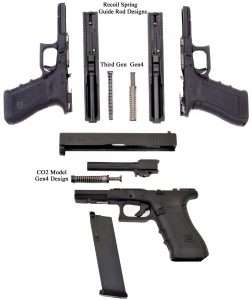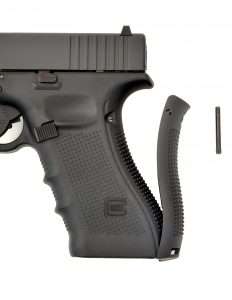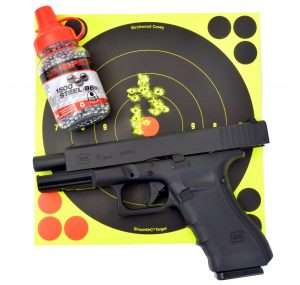Downrange with a pair of Glock 17s

This could easily have been the title of one of my reviews in Combat Handguns magazine, but it finally applies to air pistols thanks to Umarex and Glock giving the airgun world two Glock 17 models as blowback action CO2 pistols, the Third Gen and Gen4. There really isn’t much you can ask from a blowback action CO2 pistol based on a centerfire model that the new Umarex Glock 17 Gen4 does not offer (unless you absolutely must have the very latest Glock model’s understudy, a Gen5. We might see a Gen5 sometime in the future for the U.S. market, they have them in Europe already, as well as a Glock 34 and X19). At this point, however, for the U.S. market, the Gen4 checks all the boxes for a well-designed training stand-in that presents all the essential characteristics of handling and firing the centerfire pistol.

The Gen4 leaves us wanting for nothing more, except for it to equal the Third Gen’s higher velocity, and this is not likely given the internal design of the new Gen4 CO2 model, which is perhaps as close as anyone has come to building a 1:1 CO2 model in form and function. I particularly like the dual recoil spring guide rod design, not only for its physical similarity to the Gen4’s when you fieldstrip the air pistol, but for the excellent feel it imparts to basic training drills such as racking the slide, clearing the gun, or performing a press check.

Yes, you can do this with the Third Gen CO2 pistol as well, but the sensory feedback (resistance of the slide and overall impression of handling a centerfire model) is not there. The slide resistance on the Gen4 CO2 is not equal to the centerfire Glock 17, but is closer than any other blowback action CO2 model with the exception of the new Springfield armory XDM, which is equal to the Umarex Gen4, and the old, but still top notch, Umarex S&W M&P40, which runs a close second. For a Glock understudy, the Gen4 provides a lot of feedback from trigger pull to slide recoil (despite being CO2 induced), to sighting and 21 foot close quarter battle simulation accuracy.

The emphasis in this series of articles has been on authenticity and practical use as a training supplement to an actual 9x19mm Glock 17 Gen4, but there is another side to this, the simple value in a well built CO2 pistol that delivers all of the aforementioned qualities for simple target shooting with no other agenda in mind. The Gen4 checks that box as well. There is absolutely nothing about this gun not to like. It falls squarely in the middle of the velocity range for blowback action CO2 models, while delivering every popular feature available including the Glock Gen4 interchangeable backstraps.

More Details
Like the centerfire guns, the Gen4 CO2 model comes with extra backstraps in medium and large. The standard backstrap on the G17 Gen4 is small so the gun is more apt to fit a greater variety of hand sizes. This has been passed on to the CO2 model. The latest centerfire models also come with extended beavertail backstraps, and as of yet I do not know if they will fit the CO2 model, but I have a set on order, so we will find out later in the week.

Regardless, the backstraps that come with the Umarex Glock 17 Gen4 are the same design as the centerfire model and are changed the same way starting with an empty and cleared pistol. The standard cross pin in the grip frame is gently punched out from left to right and removed. You can use a correctly sized Allen wrench as a punch if you do not have a punch set. The medium or larger grip panel is placed over the backstrap, connecting to the bottom of the grip frame, and then pressed up to the top. The longer cross pin is pushed back into the channel from right to left, and you really have to press the top of the backstrap against the grip frame until the tip of the pin comes through the right as you tap it (I used a leather gunsmithing mallet). The reason for putting the pin in only from the left side is because it has knurling around the end to hold it in place, so be sure the pin is facing the right way when you insert it.

Accuracy at 21 feet
Today’s test will be the standard 21 foot comparison between the Third Gen and the Gen4 CO2 models to see if one has an accuracy edge over the other. The Third Gen has already proven itself to be one of the more accurate blowback action models, so the Gen4 really has to deliver. I will shoot the test using a traditional Weaver stance and two-handed hold, so my shooting is also a factor in the overall accuracy, but this is what I call real world testing, no benchrest.

To start I am going to run the Third Gen gun and see what I get using a Birchwood Casey Shoot-N-C target. Ammo for this test will be Umarex Precision .177 caliber steel BBs. And tests will be shot with fresh CO2.
We know the Third Gen has about a 60 fps velocity advantage over the Gen4, so at 21 feet my best 10-shot group measured 1.5 inches (thanks to a trio that I put low) but with a best 5-rounds clustered into 0.56 inches. My first seven shots hit a little high, I tried to correct to the center of the bullseye and dumped the last three under it. Up to that point I had a 0.875 inch spread going. That one is on me, but the Third Gen was still packing them in tight no matter where I aimed.

Switching to the Gen4, which I already knew required a solid hold on the bullseye, (but overlooking I had changed the backstrap, which slightly altered my grip on the gun) I put 10 rounds a little right of center into an overlapping cluster that spread 0.93 inches with a best five (at least five with overlapping hits) measuring 0.5 inches. As a fun finish for the day I took the medium grip panel back off and loaded 18 rounds in the magazine to do a 1-second interval run of all 18 rounds. At 21 feet all 18 had a total spread, shot into three groups, measuring 1.625 inches, with a best 5-shot group at 0.687 inches.

Comparisons
First, I like the trigger on the Gen4 a little more than the Third Gen. It is more precise with shorter take up and average weight of 5 pounds, 5 ounces, which is right on the factory Glock trigger pull specs; the CO2 model had a low of 4 pounds 14.5 ounces. The sights on the Gen4 are easier to get on target with the wider white outline rear and larger white dot front (much better than the Third Gen front sight). The slide recoil feels more like a light, finely tuned target pistol and less like an air pistol, so the Gen4-inspired dual recoil spring design and the amount of CO2 allocated to slide recoil are an excellent combination giving the Gen4 a more realistic feeling overall. As for accuracy, the two guns come very close and with more target time I am certain both will consistently deliver 0.5 inch to 0.875 inch groups at 21 feet. The Gen4 is just a bit more accurate. The real proof of the Gen4 will come with the final installment shooting against the Third Gen at 10 meters, where that gun has the velocity advantage at the longer distance. But right now, for 2019, unless something better comes out this year, the Gen4 is the gun to beat for Replica Air Pistol of the Year.

A word about safety
Blowback action airguns provide the look, feel and operation of their cartridge-firing counterparts and this is one reason why they have become so popular. Airguns in general all look like guns, blowback action models more so, and it is important to remember that the vast majority of people can’t tell an airgun from a cartridge gun. Never brandish an airgun in public. Always, and I can never stress this enough, always treat an airgun as you would a cartridge gun. The same manual of operation and safety should always apply.

